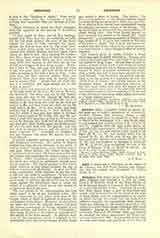

Abingdon, the Abbey of, in the County of Berkshire, England, was founded A.D. 675, by Cyssa, Viceroy of Kinwine, King of the West Saxons, or by his nephew Heane, in honor of the Virgin Mary, for twelve Benedictine monks. Endowed by successive West Saxon kings, it grew in importance and wealth until its destruction by the Danes in the reign of King Alfred, and the sequestration of its estates by Alfred because the monks had not made him a sufficient requital for vanquishing their enemies. There is a collection of 136 charters granted to this Abbey by various Saxon Kings (Cottonian MS8, apud Dugdale). Among its abbots were St. Ethelwold, afterwards Bishop of Winchester (954), and Richard de Hendred, for whose appointment the King’s consent was obtained in 1262. It is recorded of him that he wore both mitre and pontificals on the Feast of Holy Trinity in 1268. Hence Willis supposes that he was the first abbot to possess the privilege. He was present at the Council of Lyons in 1272. The last Abbot of Abingdon was Thomas Pentecost (alias Rowland), who was among the first to acknowledge the Royal Supremacy. With the rest of his community he signed the surrender of his monastery in 1538, receiving the manor of Cumnor for life or until he had preferment to the extent of £223 per annum. The revenues of the Abbey (26 Hen. VIII) were valued at £1876, 10 s, 9 d.
FRANCIS AVELING

